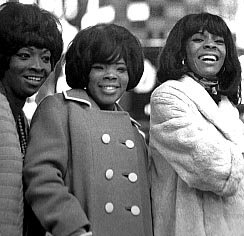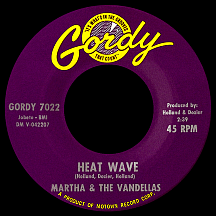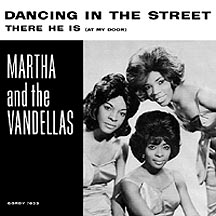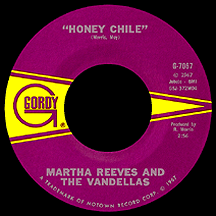MARTHA AND THE
VANDELLAS
By the time she arrived at 2648 West Grand Boulevard to live the dream, Martha Reeves had already worked as a singer and made a record. She backtracked a bit, taking on secretarial duties for the company, but it wasn't a bad move; after all, she was just out of her teens. The job lasted several months but put her right in the middle of the action, what with recently-established Motown stars like Smokey Robinson and Mary Wells coming and going and boss Berry Gordy always around, standoffishly running the entire operation (through her eyes, at least). Martha was ready and willing should any opportunity arise to get involved with what was going on in the recording studio. Eventually she got her chance.
Shortly after graduating from high school in 1959, Martha and her friend Shirley Walker put together a girl group called The Sabre-ettes; within a year and with a couple of lineup changes they were calling themselves The Fascinations (without Reeves, the group eventually hooked up with Curtis Mayfield, who composed and produced several singles for them including "Girls Are Out to Get You" in 1967). She then joined Gloria Williamson, Rosalind Ashford and Annette Beard in The Del-Phis, working as backup singers for local acts including J.J. Barnes; they recorded a single with Barnes in 1961 on the local Kable label, "Won't You Let Me Know," credited as The Dell Fi's. Chess Records took a chance with the girls, releasing their answer song, "I'll Let You Know," on the company's Check-Mate label.
The Del-Phis broke up soon afterwards and Martha took various jobs (housekeeping, waitressing) while still living with her parents. She won a local talent contest using the name Martha LaVaille and was singing at a local club when Motown A&R man Mickey Stevenson approached her about auditioning for the label. When she showed up without making an appointment, Stevenson was ready to send her home, but her enthusiasm impressed him and he asked her to answer the phone and take messages while he went to lunch. By the time he returned a few hours later, Martha had organized everything so well that he hired her as a "Girl Friday" for all the guys in the A&R department. Her real motive, of course, was to work her way into the studio and behind the microphone.
Mary Wells called in sick on the same day as a scheduled session. Martha saw her chance, stepped in and recorded "My Baby Won't Come Back," then went right back to her desk job duties. The next opportunity came when Marvin Gaye was set to record with studio group The Andantes; they weren't available, so she called Gloria, Rosalind and Annette and told them to hurry over. The session went as scheduled, but with the Del-Phis backing Marvin on "Stubborn Kind of Fellow" in place of the Andantes. A few days later they were back in the studio singing behind Saundra Mallett; the result was a dance tune, "Camel Walk." Gordy's plan at that point was to give the group credit on the single, but Chess owned the rights to the Del-Phis' name. He left it to the girls to come up with a new name and "Vandellas" was chosen, a combination of Van Dyke Street in Detroit and singer Della Reese, one of Martha's favorites. They had coined a new word, one that was surely not being used professionally by any other act.
Gordy, hoping to establish another hot girl group as he'd done with The Marvelettes (and had been attempting with the "no-hit" Supremes), tried different approaches with the girls; within days they recorded two tracks, including "There He Is (At My Door)," with Gloria singing lead. In the space of a few weeks during the summer of '62, Martha and friends had recorded the material for four single releases, all of which came out under different names on three of the company's labels. The first two were on Tamla: Saundra Mallett and the Vandellas' "Camel Walk" came first, followed by Marvin's "Stubborn" single, giving "vocal accompaniment" label credit to The Vandellas. "I'll Have to Let Him Go" (backed with Martha's earlier solo recording of "My Baby Won't Come Back" with dubbed Vandellas vocals) was released on the Gordy label, the first 45 credited to Martha and the Vandellas. In October Gordy released "There He Is" under a shortened name, The Vells, on his newest label, Mel-o-dy. Only Gaye's single became a hit and the Vandellas were relegated to session work for a few months, blending well with Marvin on his 1963 hits "Hitch Hike" and "Pride and Joy" but with no further acknowledgement on the record labels.
The "musical chairs" game of 1962 settled into a more consistent routine the following year. Saundra Mallett went missing in action (but reemerged a few years later with The Elgins). Gloria Williamson decided to leave and raise a family and the group continued as a trio with Martha, Rosalind and Annette. Gordy put them on the road with his package tour, the Motortown Revue. Things started clicking when "Come and Get These Memories," by songwriters Eddie Holland, Lamont Dozier and Brian Holland, put Martha and the Vandellas on the chart for the first time (top 30 pop and top ten R&B in the spring of '63), permanently locking in the name while inadvertently giving Reeves a certain degree of power over the other group members. "Heat Wave" established them as major hitmakers; the uptempo track, energized further by Martha's imposing vocal, lived up to its scorching title and went top ten on the pop charts in September while securing the number one spot on the R&B charts.

The Holland-Dozier-Holland team supplied the group with five hits in a row; "Quicksand" went top ten the first week of the new year, followed by the lower-charting but no less energetic "Live Wire" and "In My Lonely Room." The soon-to-be superstar songwriting trio began working with the Supremes and Four Tops in mid-1964, which gave Stevenson another shot (he had written a few early Vandellas songs); he and Marvin Gaye came up with "Dancing in the Street" for Kim Weston (the later Mrs. Stevenson), but she turned it down. Amazingly, Martha also didn't care for the song, but once they laid it down in the studio, it came alive. Good thing for the Vandellas! In October it rose to number two (held off the top spot by Manfred Mann's "Do Wah Diddy Diddy"), the greatest of Martha's hits, a number one near miss that has stood the test of time.
The first of several roster changes came about while "Dancing" was riding high: Annette Beard left, replaced by Betty Kelly of The Velvelettes (though "Needle in a Haystack" was hitting the charts at the time, she leaped at the chance to be part of a higher-profile act). "Wild One," a Stevenson-Ivy Jo Hunter song similar to "Dancing," was followed by the Holland-Dozier-Holland smash "Nowhere to Run," which became the trio's fourth top ten pop hit in April '65. They were filmed lip-syncing the song on a Ford Mustang assembly line in Detroit; one of the most famous mid-'60s "videos," it was first seen on the CBS-TV special It's What's Happening, Baby! in June.
Later in the year, "You've Been in Love Too Long" (penned by Stevenson, Hunter and Clarence Paul) went top 40, but the B side took on a life of its own; H-D-H's ballad "Love (Makes Me Do Foolish Things)," with an emotionally piercing performance by Martha (and the Andantes supplying 'Ooo' backing vocals) received airplay in many radio markets well into 1966, in the process becoming a bigger R&B hit than the A side. On its heels, "My Baby Loves Me," a Hunter-Sylvia Moy-Stevenson song, was a solid hit, again without any sign of the Vandellas to legitimize the label credit (this one featured backing by the Andantes and Four Tops).
Disagreements between the three likely had something to do with the absence of Rosalind and Betty on some of the hit singles. A pair of Holland-Dozier-Holland songs from earlier sessions were brought out for release and both were successful, adding to their string of top ten hits: "I'm Ready For Love" in December '66 and "Jimmy Mack" in April '67. By the time "Love Bug Leave My Heart Alone" (a Richard Morris-Sylvia Moy tune) hit the airwaves in late summer, Berry Gordy had made some changes in the pecking order for two of Motown's biggest acts; the Miracles became Smokey Robinson and the Miracles while the Supremes were suddenly Diana Ross and the Supremes (a decision not popular with everyone at the company or among fans). Another switch was made, to Martha Reeves and the Vandellas (Gordy's idea, not Martha's), and of the three, theirs seemed cursed from the outset.
Betty Kelly's relationship with Reeves had been touch-and-go; she departed and was replaced by Martha's younger sister, Lois Reeves. Moy, one of the composers of the lyrically rural "I Was Made to Love Her," a hit for Stevie Wonder a few months earlier, collaborated with Richard Morris on "Honey Chile," a similar down-south-styled effort. Martha connected to the song (while growing up, she had spent summer vacations with her grandparents in Alabama) and it became the group's next single...and last major hit at the end of 1967. Opinions vary on whether it was inner turmoil that caused the downturn. Putting Martha's full name up front was perceived by some as a Vandellas demotion. Rosalind Ashford left the following year, replaced by Sandra Tilley (who'd recently spent some time as a member of the Velvelettes). The group continued with Martha, Lois and Sandra, never coming close to the original group's peak of the mid-'60s, but they continued placing singles on the charts; highlights were "Bless You" in 1971 and "In and Out of My Life" in '72.
Berry Gordy moved Motown to Los Angeles in 1972 but Martha chose to stay in Detroit. He released them from their contracts and in December the group officially broke up. Martha signed with MCA Records and worked with producer Richard Perry; "Power of Love" was a minor hit in 1974. Later in the decade she recorded for the Arista and Fantasy labels. More recently she's been involved in politics and served a term on the Detroit City Council. In a satisfying turn of events, Martha and the Vandellas reunited around 1989 and Martha performed in concert with Rosalind, Annette and little sis Lois in varying configurations (based on whoever was available at any given time) for many years.
NOTABLE SINGLES:
- I'll Let You Know - 1961
by the Del-Phis - Camel Walk - 1962
by Saundra Mallett and the Vandellas - Stubborn Kind of Fellow - 1962
by Marvin Gaye with the Vandellas - I'll Have to Let Him Go - 1962
- There He Is (At My Door) - 1962
by the Vells - Come and Get These Memories - 1963
- Heat Wave /
A Love Like Yours (Don't Come Knocking Everyday) - 1963 - Quicksand - 1963
- Live Wire - 1964
- In My Lonely Room - 1964
- Dancing in the Street - 1964
- Wild One - 1964
- Nowhere to Run /
Motoring - 1965 - You've Been in Love Too Long - 1965 /
Love (Makes Me Do Foolish Things) - 1966 - My Baby Loves Me - 1966
- What Am I Going to Do Without Your Love - 1966
- I'm Ready For Love - 1966
- Jimmy Mack /
Third Finger, Left Hand - 1967 - Love Bug Leave My Heart Alone - 1967
- Honey Chile - 1967
as Martha Reeves and the Vandellas - I Promise to Wait My Love - 1968
as Martha Reeves and the Vandellas /
Forget Me Not - 1968
as Martha Reeves and the Vandellas - I Can't Dance to That Music You're Playin' - 1968
as Martha Reeves and the Vandellas - Sweet Darlin' - 1968
as Martha Reeves and the Vandellas - (We've Got) Honey Love - 1969
as Martha Reeves and the Vandellas - Taking My Love (And Leaving Me) - 1969
as Martha Reeves and the Vandellas - I Gotta Let You Go - 1970
as Martha Reeves and the Vandellas - Bless You - 1971
as Martha Reeves and the Vandellas - In and Out of My Life - 1972
as Martha Reeves and the Vandellas - Power of Love - 1974
by Martha Reeves





